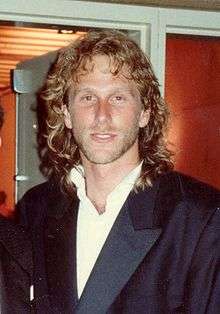Peter Horton
| Peter Horton | |
|---|---|
 Horton at the Governor's Ball, following the 40th Annual Primetime Emmy Awards, 1988 | |
| Born |
August 20, 1953 Bellevue, Washington, U.S. |
| Years active | 1964-present |
| Spouse(s) |
Michelle Pfeiffer (1981-1988) Nicole Deputron (1995-present) |
| Children | 2 |
Peter Horton (born August 20, 1953) is an American actor and director. He is perhaps best known for the role of Professor Gary Shepherd on the popular television series Thirtysomething which he played from 1987 until 1991.
Early life
Horton was born in Bellevue, Washington, to a father who worked in the shipping business.[1] He attended Redwood High School in Marin County, California, and Principia College in Illinois.[2][3]
Career
During his run on Thirtysomething, People magazine named him one of the "50 Most Beautiful People". Horton acted in television shows including St. Elsewhere, The White Shadow, Dallas, Eight Is Enough, "In Treatment" and The Geena Davis Show, played the lead in the short-lived series Brimstone, and played Crane McFadden in the one season series (1982–1983) "Seven Brides for Seven Brothers". He played Jacob in the 1982 feature film Split Image, Father Mahoney in the 1986 feature film "Where the River Runs Black" Roy Fox in the 1996 film "Two Days In The Valley" and played Burt in the 1984 Stephen King movie Children of the Corn. He had a minor role in Cameron Crowe's Seattle romantic comedy, Singles. He played Harry Landers in the "Hospital" skit from Amazon Women on the Moon opposite wife Michelle Pfeiffer, whom he had previously directed in the ABC Afterschool Special One Too Many in 1985. Horton also appeared in the 1997 TV movie version of the Jon Krakauer book Into Thin Air: Death on Everest, playing Scott Fischer, the leader of the disastrous 1996 climb on Mount Everest. He was also in the movie Sideout (1990) as Zach Barnes, a down and out ex-volley ball champ. As a director he has worked on several television series including The Shield, Thirtysomething, The Wonder Years, Once and Again, and directed the pilot for Grey's Anatomy as well as pilots for Class of '96, Birdland, Dirty Sexy Money, The Philanthropist and Reconstruction. He directed the 1990 film for television Extreme Close-up as well as the 1995 feature film The Cure. As a producer he produced Reconstruction (which he co-created), Lone Star, The Philanthropist, The Body Politic (which he also co-created), Grey's Anatomy, Six Degrees and Murder Live (for which he wrote the story).
He appeared in Who Killed the Electric Car? and is on the board of directors of the Environmental Alliance.[4]
As of 2010 Horton is an executive producer and director of Grey's Anatomy on ABC, and produces and directs NBC's The Philanthropist.
Personal life
Horton was married to Michelle Pfeiffer, whom he met in Milton Katselas' acting class,[5] from 1981 to 1988. He pried the future Hollywood star from a vegan cult: "I don't believe in women being saved by men, but ... I was very lucky," Pfeiffer later recalled. "Peter drew me back into the world."[6] Of their relationship, Pfeiffer reflected, "I broke one of my own Ten Commandments never to date an actor, especially one you study with. Then I married one!"[7] Their separation was amicable; Horton later blamed it on their devotion to their work rather than on their marriage.[8]
He has been married to Nicole Deputron since 1995 and the couple have two children, Lily (b. October 1999) and Ruby (b. 2002). He is a brother-in-law of Egil Krogh, a former White House Plumber who was convicted in the Watergate scandal.
References
- ↑ "Peter Horton Biography (1953-)". Filmreference.com. Retrieved 2013-07-06.
- ↑ "Peter Horton Biography - Yahoo! Movies". Movies.yahoo.com. Retrieved 2013-07-06.
- ↑ "CNN Larry King Live Interview with Linda Hamilton, (transcript)". cnn.com. 2005-10-14. Retrieved 2008-01-02.
I was not married to Peter Horton, which is sort of all over the Web site that I've been married three times, so I look like -- but for some reason that's false information. I was never married to Peter Horton.
- ↑ Archived September 3, 2005, at the Wayback Machine.
- ↑ D. Thompson, Pfeiffer: Beyond the Age of Innocence, London, Warner Books, 1995, p. 45.
- ↑ Thompson, Pfeiffer, pp. 46-7.
- ↑ Thompson, Pfeiffer, p. 47.
- ↑ Thompson, Pfeiffer, pp. 92-3.